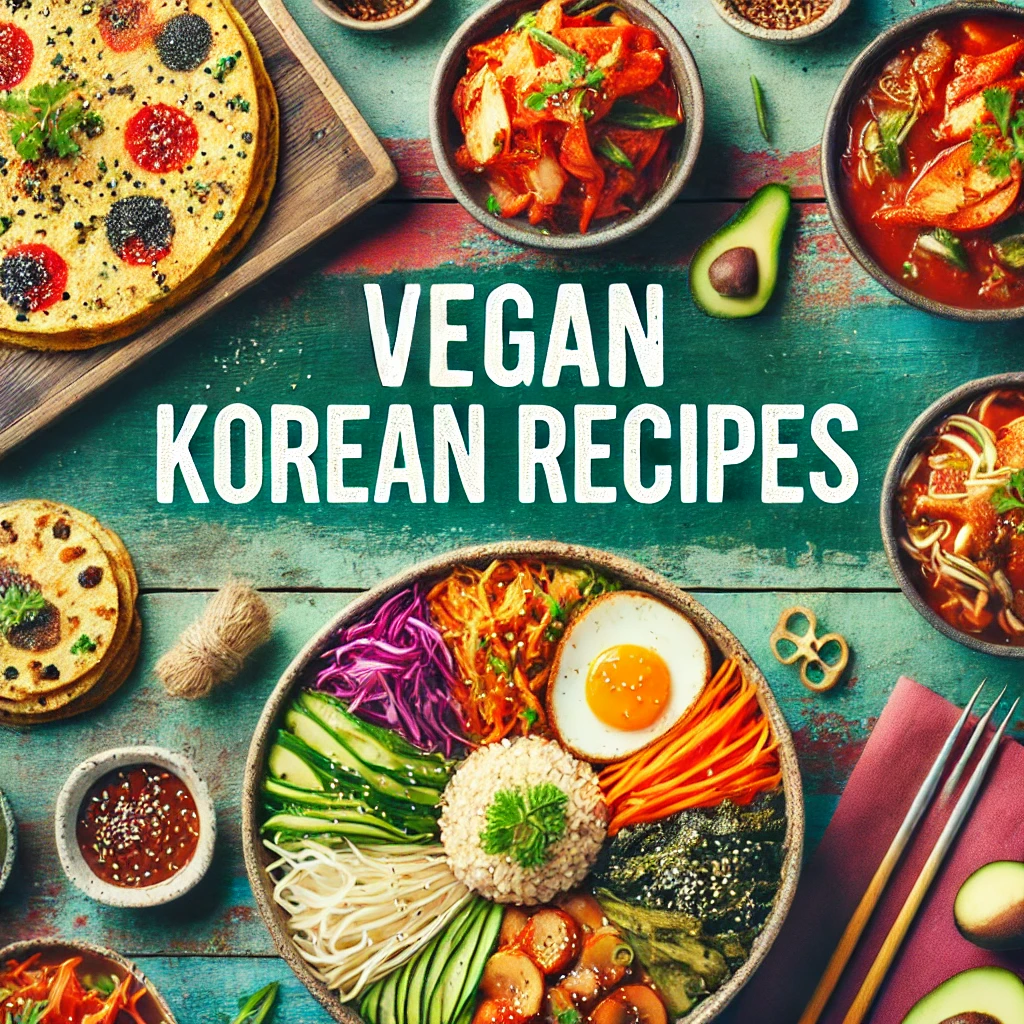Korean cuisine is known for its vibrant flavors, rich in vegetables, fermented ingredients, and bold spices. Although many traditional Korean dishes often contain meat, fish, or seafood-based ingredients like fish sauce or anchovy broth, it’s possible to enjoy authentic vegan versions of traditional Korean food. Whether you’re already a plant-based eater or simply exploring vegan options, adapting Korean recipes for a vegan diet can be delicious, satisfying, and easy to achieve.
This guide will introduce you to several vegan Korean dishes that stay true to the essence of Korean cuisine while omitting animal products. From savory stews to hearty side dishes, these recipes are packed with flavor and nutrition, all while being 100% plant-based.

1. Vegan Kimchi (김치)
Why Kimchi is a Staple in Korean Cuisine
Kimchi, a fermented cabbage dish seasoned with chili, garlic, and ginger, is one of Korea’s most iconic foods. Traditionally, kimchi is made with fish sauce or shrimp paste, but making a vegan version is easy and just as flavorful.
Ingredients
- 1 large napa cabbage (about 1.5 kg)
- 1/4 cup coarse sea salt
- 1/2 cup gochugaru (Korean red pepper flakes)
- 1 small daikon radish, julienned
- 4 green onions, chopped
- 1/4 cup soy sauce or tamari (for gluten-free)
- 1/4 cup Korean pear (or apple), grated
- 1 tbsp sugar (or sweetener of choice)
- 4 cloves garlic, minced
- 1 tbsp ginger, minced
- 1/4 cup water
Instructions
- Salt the cabbage: Cut the napa cabbage into quarters and sprinkle salt between the leaves. Let the cabbage sit for 1-2 hours, turning it occasionally. Rinse thoroughly and drain.
- Prepare the paste: In a bowl, combine gochugaru, soy sauce, grated pear, sugar, garlic, ginger, and water to make the seasoning paste.
- Mix the vegetables: In a large bowl, toss the cabbage with the julienned daikon radish and green onions. Add the seasoning paste and massage it into the cabbage until all leaves are coated.
- Ferment: Pack the kimchi into a clean jar, pressing down to remove air pockets. Leave about 1 inch of space at the top. Cover and let it ferment at room temperature for 1-2 days, then transfer to the fridge. It will continue to ferment slowly over time, developing a deeper flavor.
Nutritional Information (Per Serving)
- Calories: ~50 kcal
- Protein: 2g
- Carbs: 10g
- Fat: 0g
Why It’s Healthy
Kimchi is rich in probiotics due to fermentation, which is great for gut health. It’s also packed with vitamins, antioxidants, and fiber from vegetables, making it a nutritious side dish or topping for many meals.
SEO Tip:
- Keywords: vegan kimchi recipe, plant-based kimchi, traditional Korean kimchi for vegans
- Related Searches: how to make vegan kimchi, Korean vegan side dish
2. Vegan Bibimbap (비빔밥)
Why Bibimbap is Perfect for Vegans
Bibimbap is a well-known Korean mixed rice dish, traditionally topped with vegetables, protein, and gochujang sauce. Making a vegan version is easy by using plant-based proteins like tofu or tempeh and omitting the egg.
Ingredients
- 1 cup cooked white or brown rice
- 1/2 cup spinach, blanched and seasoned with sesame oil
- 1/2 carrot, julienned
- 1/2 zucchini, julienned
- 1/4 cup shiitake mushrooms, sliced
- 1/4 block of firm tofu, pan-fried
- 1 tbsp gochujang (Korean red chili paste)
- 1 tsp sesame oil
- 1 tbsp soy sauce or tamari (for gluten-free)
- 1 tsp sesame seeds
Instructions
- Prepare the vegetables: Sauté the carrots, zucchini, and mushrooms individually in a small amount of sesame oil and soy sauce until tender. Blanch the spinach and season it with sesame oil.
- Cook the tofu: Slice the tofu and pan-fry it in a non-stick skillet until golden on both sides.
- Assemble the bibimbap: In a large bowl, place the cooked rice at the bottom. Arrange the cooked vegetables and tofu on top in sections.
- Top and serve: Add a spoonful of gochujang in the center and drizzle with sesame oil. Sprinkle sesame seeds over the top. Mix everything together before eating.
Nutritional Information (Per Serving)
- Calories: ~350 kcal
- Protein: 12g
- Carbs: 50g
- Fat: 10g
Why It’s Healthy
Bibimbap is a balanced meal that offers a variety of vegetables and plant-based protein, making it a nutrient-dense option. Gochujang adds spice and depth to the dish without needing heavy sauces, and the sesame oil provides healthy fats.
SEO Tip:
- Keywords: vegan bibimbap recipe, plant-based Korean mixed rice, easy vegan bibimbap
- Related Searches: how to make bibimbap without meat, Korean vegan rice dish
3. Vegan Japchae (잡채)
Why Japchae is Naturally Vegan-Friendly
Japchae is a popular Korean dish made with sweet potato noodles and stir-fried vegetables. While it’s often served with beef, the dish is naturally gluten-free and easily adapted for vegans by using plant-based ingredients.
Ingredients
- 200g sweet potato glass noodles (dangmyeon)
- 1/2 onion, sliced
- 1/2 carrot, julienned
- 1/2 red bell pepper, sliced
- 1/2 cup spinach, blanched
- 4 shiitake mushrooms, sliced
- 2 tbsp soy sauce or tamari (for gluten-free)
- 1 tbsp sesame oil
- 1 tsp sugar
- 1 clove garlic, minced
- Sesame seeds for garnish
Instructions
- Cook the noodles: Cook the sweet potato noodles according to package instructions. Rinse under cold water and drain well.
- Sauté the vegetables: In a large pan, heat sesame oil and sauté the onions, carrots, bell peppers, and mushrooms until soft. Add the garlic and cook for another minute.
- Combine everything: Add the cooked noodles and blanched spinach to the pan with the vegetables. Stir in the soy sauce, sugar, and an extra drizzle of sesame oil. Toss until everything is well combined.
- Serve: Garnish with sesame seeds and serve warm or at room temperature.
Nutritional Information (Per Serving)
- Calories: ~300 kcal
- Protein: 4g
- Carbs: 60g
- Fat: 8g
Why It’s Healthy
Japchae is made with sweet potato noodles, which are naturally gluten-free and a great source of complex carbohydrates. The vegetables provide fiber and vitamins, while sesame oil adds healthy fats and flavor.
SEO Tip:
- Keywords: vegan japchae recipe, gluten-free Korean noodles, plant-based japchae
- Related Searches: how to make vegan japchae, Korean sweet potato noodles recipe
4. Vegan Doenjang Jjigae (된장찌개)
Why Doenjang Jjigae is a Comfort Food
Doenjang Jjigae is a savory, hearty Korean stew made with fermented soybean paste (doenjang), tofu, and vegetables. The fermented soybean paste gives it a rich, umami flavor, and it’s naturally vegan when made without meat or fish broth.
Ingredients
- 2 tbsp doenjang (Korean fermented soybean paste)
- 4-5 shiitake mushrooms, sliced
- 1 zucchini, sliced
- 1/2 onion, diced
- 1 block of firm tofu, cubed
- 2-3 cups water or vegetable broth
- 1 clove garlic, minced
- 1 tbsp soy sauce
- Green onions for garnish
Instructions
- Prepare the broth: In a pot, bring water or vegetable broth to a boil. Add the minced garlic and doenjang paste, stirring until the paste is dissolved.
- Add vegetables: Add the shiitake mushrooms, zucchini, and onions to the pot. Let the stew simmer for 10-15 minutes until the vegetables are tender.
- Add tofu: Stir in the tofu cubes and soy sauce. Cook for another 5 minutes until the tofu is heated through.
- Serve: Garnish with chopped green onions and serve with steamed rice.
Nutritional Information (Per Serving)
- Calories: ~200 kcal
- Protein: 12g
- Carbs: 15g
- Fat: 10g
Why It’s Healthy
Doenjang Jjigae is rich in protein from the tofu and contains probiotics from the fermented soybean paste, making it excellent for gut health. The stew is also packed with vegetables, adding fiber and nutrients to the dish.
SEO Tip:
- Keywords: vegan doenjang jjigae, Korean soybean paste stew, plant-based Korean soup
- Related Searches: how to make vegan doenjang jjigae, Korean tofu stew recipe
5. Vegan Kimbap (김밥)
Why Kimbap is a Fun Vegan Snack
Kimbap is Korea’s version of sushi rolls, made with rice and various fillings wrapped in seaweed (gim). By omitting traditional fillings like fish or eggs, you can create flavorful vegan kimbap with ingredients like tofu, pickled radish, and fresh vegetables.
Ingredients
- 2 cups cooked short-grain rice (seasoned with 1 tbsp rice vinegar)
- 4 sheets of roasted seaweed (gim)
- 1/4 block of firm tofu, sliced into thin strips and pan-fried
- 1 carrot, julienned
- 1 cucumber, julienned
- 4 strips of pickled yellow radish (danmuji)
- 1/2 avocado, sliced
- Soy sauce for dipping (optional)
Instructions
- Prepare the fillings: Cook the rice and season it with rice vinegar. Pan-fry the tofu slices until golden and set aside. Slice the carrot, cucumber, avocado, and radish into thin strips.
- Assemble the kimbap: Place a sheet of roasted seaweed on a bamboo mat. Spread a thin layer of rice over the seaweed, leaving a 1-inch gap at the top. Arrange the tofu, carrot, cucumber, radish, and avocado in the center of the rice.
- Roll the kimbap: Using the bamboo mat, roll the kimbap tightly, pressing gently as you go. Seal the edge with a bit of water.
- Slice and serve: Slice the kimbap into bite-sized pieces and serve with soy sauce for dipping if desired.
Nutritional Information (Per Roll)
- Calories: ~300 kcal
- Protein: 8g
- Carbs: 50g
- Fat: 7g
Why It’s Healthy
Kimbap is a fun and nutritious snack that’s perfect for on-the-go meals or picnics. It’s packed with fresh vegetables, offering fiber and essential nutrients, while the tofu provides plant-based protein.
SEO Tip:
- Keywords: vegan kimbap recipe, Korean seaweed rolls, plant-based sushi rolls
- Related Searches: how to make vegan kimbap, Korean vegan snack ideas
Conclusion: Enjoying Traditional Korean Food on a Vegan Diet
These vegan Korean recipes prove that you don’t need to sacrifice flavor or authenticity when following a plant-based diet. From the tangy and spicy flavors of kimchi to the comforting richness of doenjang jjigae, these dishes are perfect for anyone looking to enjoy traditional Korean food without animal products. Whether you’re cooking for yourself, friends, or family, these vegan-friendly dishes are sure to impress.
SEO Tip Recap:
- Main Keywords: vegan Korean food, plant-based Korean recipes, traditional Korean dishes for vegans
- Related Searches: how to make vegan Korean food, Korean plant-based diet, easy Korean vegan recipes
Try out these recipes and enjoy the delicious flavors of Korea, all while staying true to your vegan lifestyle!













